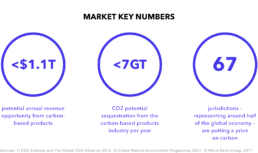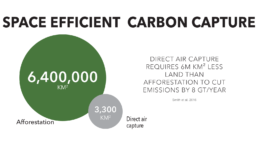Urgently cutting carbon emissions at source is essential to mitigating catastrophic climate change, and negative emissions are needed to keep us on the well below 2°C pathway. Business is increasingly discovering ways to upcycle carbon, generating more value, emitting less and accelerating carbon negative technologies.
In 2017, atmospheric concentrations of carbon dioxide exceeding 410 parts per million were recorded at the Mauna Loa Observatory in Hawaii – a level not seen on Earth for the last 15 million years. For centuries, our entire economies relied on burning fossil fuels to generate useful energy, and the release of CO2 was considered an inconsequential byproduct. We now know however, that this accumulation will change life on Earth, and without fast action, climate change will have catastrophic consequences. To achieve net-zero emissions by 2050, business is investing in clean technology, reducing risks and building resilience. The maturing carbon price is enabling business to reimagine carbon as a resource in commercial activities, gaining more value from less carbon.
According to some scenarios, keeping global warming below 1.5°C by 2100 will require a combination of negative emissions technologies and other mitigation options. Depending on the scenarios used, some research suggests that the carbon-based products industry has the potential to capture 1-7 Gt CO2 per year, bridging 3-20% of the gap between the current commitments under the Paris Agreement and the well below 2°C goal. According to the 2017 UN Emissions Gap Report, material science and manufacturing could yield a breakthrough to fast-track the development and bring down costs of wider CO2 removal technology, driving towards a zero-carbon, circular economy.

Products and Services
As the social and economic drive to reduce carbon emissions increases, companies are looking to maximise value from less carbon. Since carbon is a fundamental ingredient in the global manufacturing industry, CO2 is being integrated into existing processes, especially for production of chemicals, fuels, construction materials and plastics. One firm in India is using waste industrial CO2 to make bio-oils, while a British company uses it to make sofas and car parts, and others are creating new plastics from the greenhouse gases. Ongoing research is working on converting carbon into fuels and even edible proteins, where renewable energy can make these innovations both economically and environmentally feasible.

Market Size and Demand Drivers
Carbon-based products can tap into a vast number of growing markets, such as methanol production, which has a forecast 7-9% CAGR to 2030. It is estimated that up to 10% of annual CO2 emissions can be captured in these products, with a potential annual revenue opportunity of $800 billion to $1.1 trillion. Key market drivers in this opportunity space are technological advances allowing concentration of atmospheric CO2, as well as regulation and market-based policy tools that are delivering effective carbon prices.
Utilising atmospheric carbon in new products does not tackle the root cause of climate change, and may only have a small climate mitigation impact. It must not be seen as a silver bullet or a reason not to pursue other solutions that accelerate progress towards a carbon-neutral economy. However, removing carbon from the atmosphere, and upcycling it into new products can be a way to decouple growth from carbon emissions, and provide competencies to accelerate the development of wider carbon negative technologies.
This market featured in the 2018 Global Opportunity Report.

